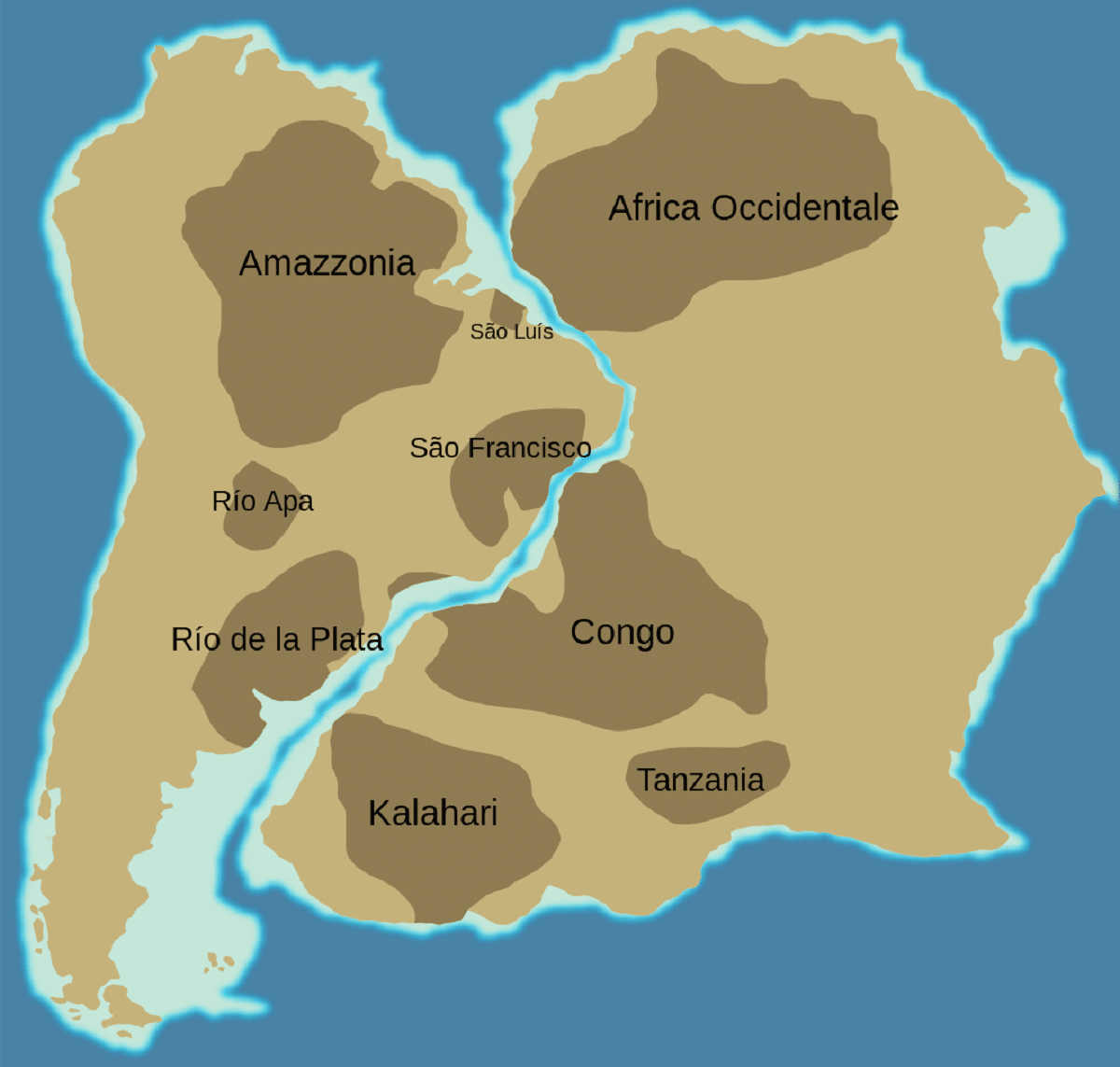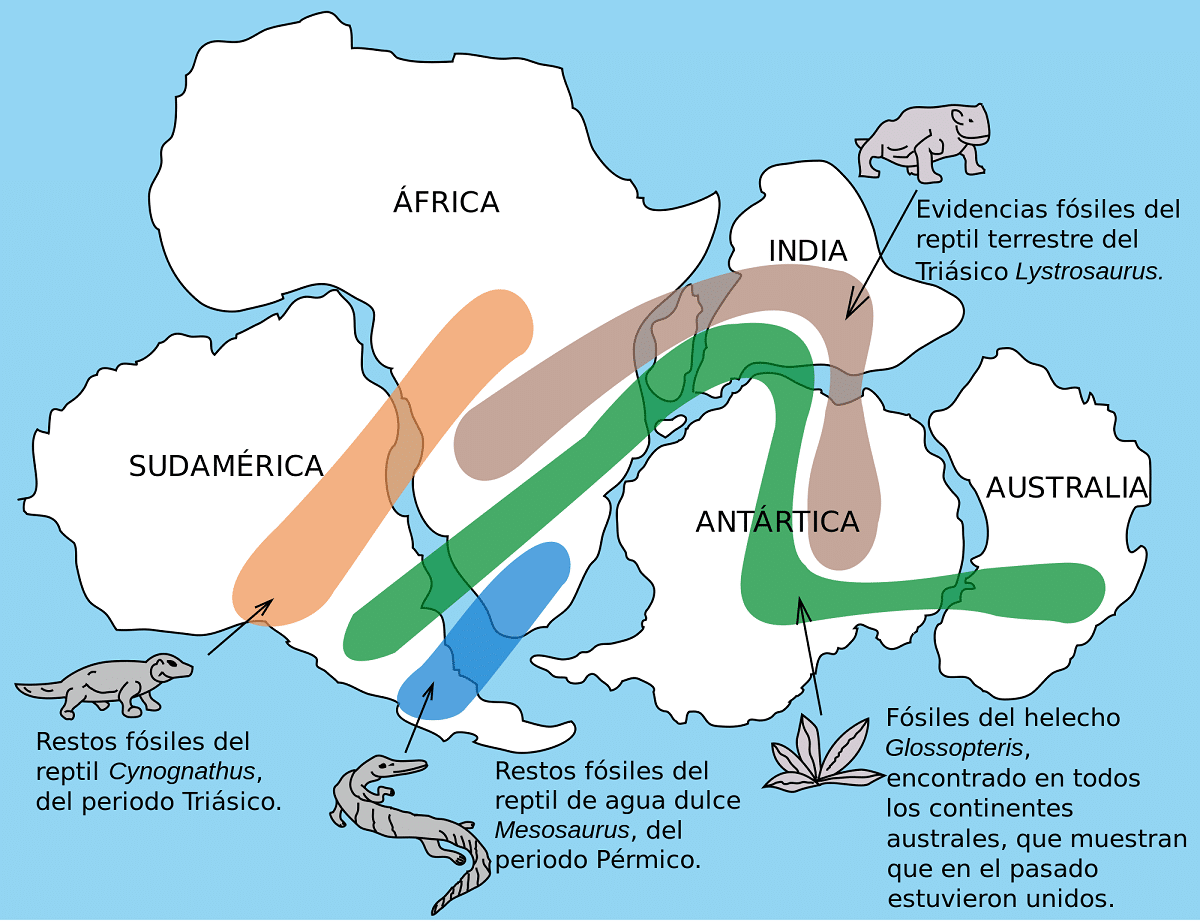
In the past, continents were thought to have remained fixed for millions of years. Nothing was known that the Earth's crust was made up of plates that move thanks to the convection currents of the mantle. However, scientist Alfred Wegener proposed the theory of continental drift. This theory said that the continents had drifted for millions of years and that they were still doing so.
From what can be expected, this theory was quite a revolution for the world of science and geology. Do you want to learn everything about continental drift and discover its secrets?
Theory of continental drift

This theory refers to the current movement of the plates that sustain the continents and that move over millions of years. Throughout the geological history of the Earth, the continents have not always been in the same position. There is a series of evidences that we will see later that helped Wegener to refute his theory.
The movement is due to the continual formation of new material from the mantle. This material is created in the oceanic crust. In this way, the new material exerts a force on the existing one and causes the continents to shift.
If you look closely at the shape of all the continents, it seems as if America and Africa have been united. In this the philosopher noticed Francis Bacon in the year 1620. However, he did not propose any theory that these continents had stayed together in the past.
This was mentioned by Antonio Snider, an American who lived in Paris. In 1858 he raised the possibility that the continents could be moving.
It was already in 1915 when the German meteorologist Alfred Wegener published his book called "The origin of the continents and oceans". In it he exposed the entire theory of continental drift. For this reason, Wegener is considered the author of the theory.
In the book he explained how our planet had hosted a kind of supercontinent. That is, all the continents that we have today were once together forming one. He called that supercontinent Pangea. Due to the internal forces of the Earth, Pangea would fracture and move away piece by piece. After the passage of millions of years, the continents would occupy the position that they do today.
Evidence and evidence

According to this theory, in the future, millions of years from now, the continents will meet again. What made it important to demonstrate this theory with proof and evidence.
Paleomagnetic tests
The first evidence that made them believe him was the explanation of paleo magnetism. Earth's magnetic field it has not always been in the same orientation. Every so often, the magnetic field has reversed. What is now the magnetic south pole used to be the north, and vice versa. This is known because many high metal content rocks acquire an orientation towards the current magnetic pole. Magnetic rocks have been found whose north pole points to the south pole. So, in ancient times, it must have been the other way around.
This paleomagnetism could not be measured until the 1950s. Although it was possible to measure, very weak results were taken. Still, analysis of these measurements managed to determine where the continents were. You can tell this by looking at the orientation and age of the rocks. In this way, it could be shown that all the continents were once united.
Biological tests
Another of the tests that puzzled more than one were the biological ones. Both animal and plant species are found on various continents. It is unthinkable that species that are not migratory can move from one continent to another. Which suggests that at one time they were on the same continent. The species were dispersing with the passage of time, as the continents moved.
Also, in western Africa and eastern South America rock formations of the same type and age are found.
One discovery that prompted these tests was the discovery of fossils of the same deciduous fern in South America, South Africa, Antarctica, India and Australia. How can the same species of fern be from several different places? It was concluded that they lived together in Pangea. Lystrosaurus reptile fossils were also found in South Africa, India and Antarctica, and Mesosaurus fossils in Brazil and South Africa.
Both the flora and the fauna belonged to the same common areas that grew apart over time. When the distance between continents was too great, each species adapted to the new situations.
Geological tests
It has already been mentioned that the edges of the continental shelves of Africa and America fit together perfectly. And they were once one. In addition, they not only have in common the puzzle shape, but the continuity of the mountain ranges of the South American continent and the African. Today the Atlantic Ocean is in charge of separating these mountain ranges.
Paleoclimatic tests
The climate also helped the interpretation of this theory. Evidence of the same erosive pattern was found on different continents. At present, each continent has its own regime of rainfall, winds, temperatures, etc. However, when all the continents formed one, there was a unified climate.
Furthermore, the same moraine deposits have been found in South Africa, South America, India and Australia.
Stages of continental drift

Continental drift has been occurring throughout the history of the planet. According to the position of the continents on the globe, life has been shaped in one way or another. This has meant that continental drift has more marked stages that mark the beginning of the formation of continents and, with it, of new ways of life. We remember that living beings need to adapt to the environment and, depending on their climatic conditions, evolution is marked by different characteristics.
We are going to analyze which are the main stages of continental drift:
- About 1100 billion years ago: the formation of the first supercontinent took place on the planet called Rodinia. Contrary to popular belief, Pangea was not the first. Even so, the possibility that other previous continents have existed is not ruled out, although there is not enough evidence.
- About 600 billion years ago: Rodinia took about 150 million years to fragment and a second supercontinent called Pannotia took shape. It had a shorter duration, of only 60 million years.
- About 540 million years ago, Pannotia fragmented into Gondwana and Proto-Laurasia.
- About 500 billion years ago: Proto-Laurasia was divided into 3 new continents called Laurentia, Siberia and Baltic. In this way, this division generated 2 new oceans known as Iapetus and Khanty.
- About 485 billion years ago: Avalonia separated from Gondwana (the land corresponding to the United States, Nova Scotia, and England. The Baltic, Laurentia, and Avalonia collided to form Euramérica.
- About 300 billion years ago: there were only 2 large continents. On the one hand, we have Pangea. it existed about 225 million years ago. Pangea was the existence of a single supercontinent where all living beings spread. If we look at the geological time scale, we see that this supercontinent existed during the Permian period. On the other hand, we have Siberia. Both continents were surrounded by the Panthalassa Ocean, the only ocean present.
- Laurasia and Gondwana: As a result of the breakup of Pangea, Laurasia and Gondwana were formed. Antarctica also began to form throughout the Triassic period. It happened 200 million years ago and a differentiation of the species of living beings began to occur.
Current distribution of living things
Although once the continents were separated each species acquired a new branch in evolution, there are species with the same characteristics on different continents. These analyzes bear a genetic resemblance to species from other continents. The difference between them is that they have evolved over time by finding themselves in new settings. An example of this is the garden snail which has been found in both North America and Eurasia.
With all this evidence, Wegener tried to defend his theory. All of these arguments were quite convincing to the scientific community. He had really discovered a great find that would allow a breakthrough in science.
I like it, I think the theory is very good and I do believe that America and Africa would have been united because it seems like a puzzle. 🙂